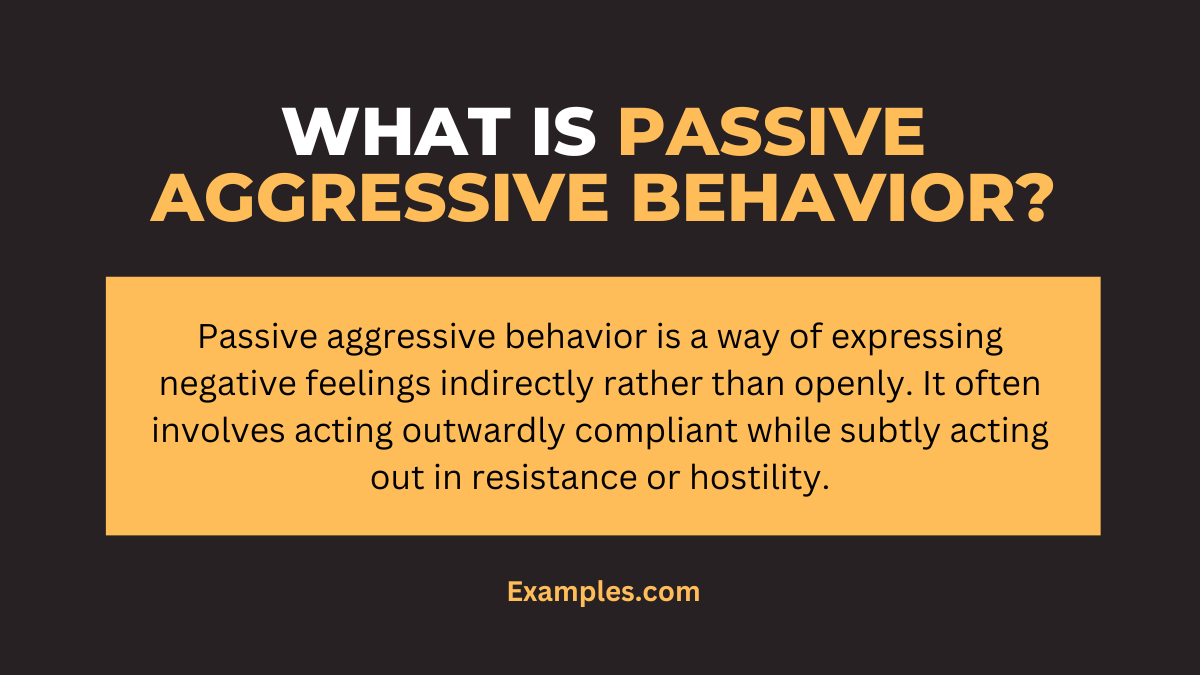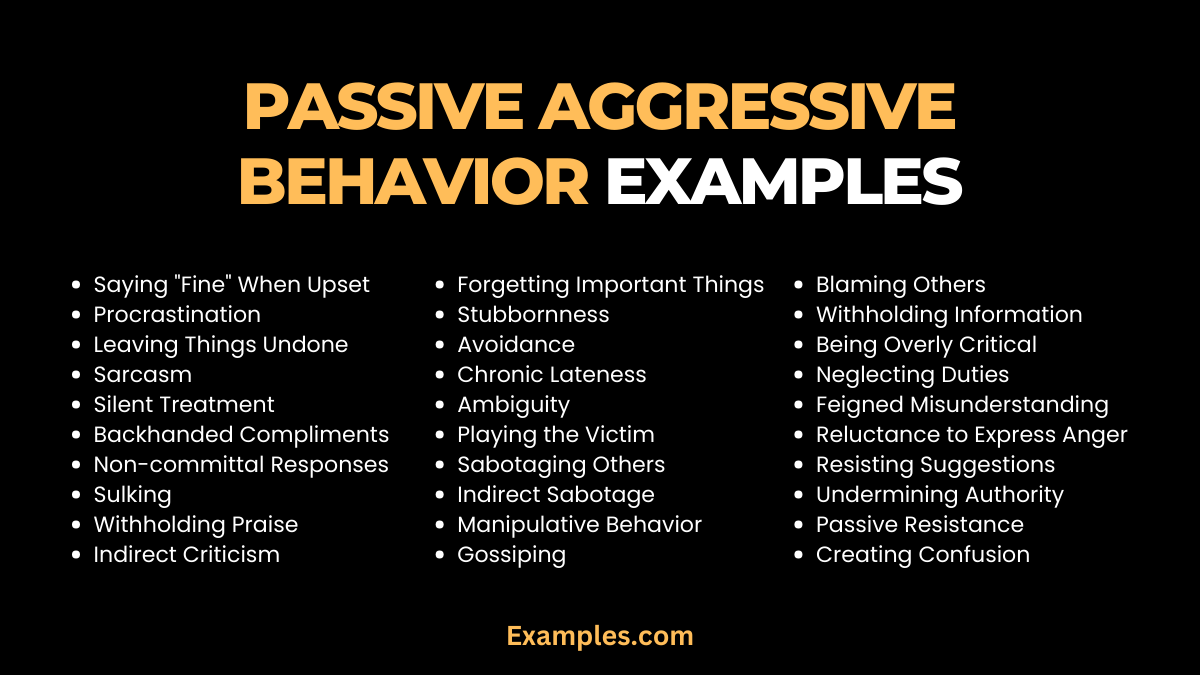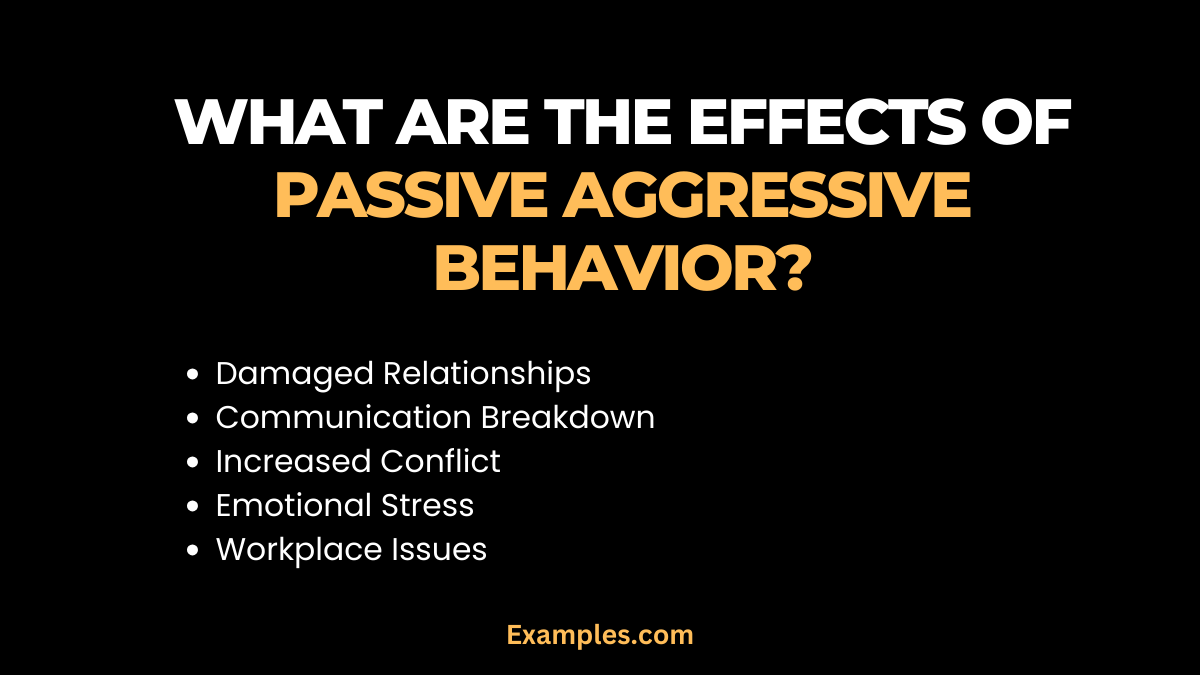29+ Passive Aggressive Behavior Examples
Discover the nuances of passive-aggressive behavior with our thorough guide. This resource delves into various examples and scenarios, helping you recognize and understand this complex form of communication. Whether in personal relationships or professional environments, our guide provides insights into identifying and effectively dealing with passive-aggressiveness. Enhance your interpersonal skills and navigate challenging interactions with confidence. Perfect for anyone looking to improve communication dynamics in all aspects of life.
What is Passive Aggressive Behavior?

Passive aggressive behavior is a way of expressing negative feelings indirectly rather than openly. It often involves acting outwardly compliant while subtly acting out in resistance or hostility. Key characteristics include avoiding direct confrontation, expressing resentment through actions rather than words, and using tactics like silent treatment or sarcasm. This behavior can lead to miscommunication and strained relationships, making it important to recognize and address.
30 Passive Aggressive Behavior Examples

Passive-aggressive behavior is a subtle yet impactful form of communication that often manifests in indirect resistance, avoidance, and evasion. It can lead to misunderstandings and tension in various relationships, whether personal or professional. Recognizing these behaviors is key to addressing and resolving underlying issues.
- Saying “Fine” when upset: When someone is clearly upset but insists they’re “fine,” it’s a classic sign of passive aggression.
- Procrastination: Deliberately delaying tasks as a form of resistance.
- Leaving things undone: Intentionally neglecting responsibilities.
- Sarcasm: Using sarcastic remarks to mask true feelings.
- Silent treatment: Refusing to communicate as a form of control.
- Backhanded compliments: Giving compliments that actually feel insulting.
- Non-committal responses: Giving vague answers to avoid direct communication.
- Sulking: Displaying unhappiness subtly to gain attention or sympathy.
- Withholding praise: Intentionally not acknowledging someone’s achievements.
- Indirect criticism: Criticizing someone through hints instead of direct communication.
- Forgetting important things: Pretending to forget as an act of resistance.
- Stubbornness: Refusing to change one’s stance, even when it’s unreasonable.
- Avoidance: Deliberately avoiding someone instead of addressing issues.
- Chronic lateness: Consistently being late as a form of control.
- Ambiguity: Being intentionally vague to avoid commitment or responsibility.
- Playing the victim: Portraying oneself as the wronged party to avoid blame.
- Sabotaging others: Hindering someone’s efforts in a subtle way.
- Indirect sabotage: Causing problems without overtly taking responsibility.
- Manipulative behavior: Influencing others indirectly for personal gain.
- Gossiping: Spreading rumors instead of addressing issues directly.
- Blaming others: Shifting responsibility to avoid accountability.
- Withholding information: Intentionally not sharing information to maintain control.
- Being overly critical: Criticizing everything as a form of control.
- Neglecting duties: Ignoring responsibilities to express dissatisfaction.
- Feigned misunderstanding: Pretending not to understand to avoid action.
- Reluctance to express anger: Hiding true feelings of anger behind a facade.
- Resisting suggestions: Opposing ideas just to be contrary.
- Undermining authority: Subtly challenging authority figures.
- Passive resistance: Resisting demands or requests in a non-confrontational way.
- Creating confusion: Intentionally being unclear to keep others off-balance.
Passive Aggressive Behavior Examples in a Relationship
Passive-aggressive behavior in relationships manifests through indirect expressions of hostility and discontent. Instead of open communication, partners may resort to tactics like silent treatment, sarcastic comments, or backhanded compliments. These behaviors can create a toxic atmosphere, eroding trust and intimacy.
- Silent treatment after an argument: Instead of discussing issues openly, one partner resorts to prolonged silence, indirectly expressing their displeasure or frustration.
- Backhanded compliments: Compliments that actually carry a negative or critical undertone, subtly undermining the partner’s confidence.
- Sarcastic remarks during disagreements: Using sarcasm as a tool to express dissatisfaction or disagreement without directly addressing the issue.
- Feigned forgetfulness: Pretending to forget important dates or promises as a means of expressing resentment or disappointment.
- Withdrawing affection to punish: Intentionally becoming cold or distant as a means of punishment without openly discussing the problem.
Passive Aggressive Behavior Examples at Work
In the workplace, passive-aggressive behavior often involves subtle acts of resistance or non-cooperation. This could range from procrastination and spreading rumors to feigned incompetence. Such behaviors can undermine team dynamics and affect overall productivity.
- Procrastination on assigned tasks: Deliberately delaying work or responsibilities to indirectly express opposition or resentment towards a colleague or supervisor.
- Spreading rumors or gossip: Indirectly undermining a colleague’s reputation or position by spreading unverified or negative information.
- Non-cooperation in team activities: Showing a lack of enthusiasm or participation in team projects, signaling displeasure or disagreement with the team’s direction.
- Subtle sabotage of projects: Making small, seemingly innocent mistakes that negatively impact a project’s progress or success.
- Feigned incompetence to avoid tasks: Pretending to be unable to complete a task effectively, thereby shifting the responsibility to others.
Passive Aggressive Behavior Examples in the Workplace
Passive-aggressive behavior in the workplace includes actions like constantly arriving late to meetings or sending overly critical emails. These behaviors are typically used to express dissatisfaction or resistance in an indirect manner, impacting workplace relationships and efficiency.
- Constantly arriving late to meetings: Repeatedly showing up late as an indirect way to express dissatisfaction with the meetings or the organizer.
- Overly critical emails: Sending emails that are excessively critical or have a negative tone, without addressing concerns directly.
- Agreeing to tasks verbally but not following through: Verbally committing to tasks but intentionally failing to complete them on time or properly.
- Withholding important information: Deliberately not sharing crucial information with colleagues as a form of indirect control or power play.
- Sighing or eye-rolling during discussions: Displaying non-verbal cues of disagreement or annoyance in meetings without openly voicing concerns.
What are the Signs Of Passive-Aggressive Behavior?
Here are the Signs Of Passive-Aggressive Behavior:
- Indirect Communication: Avoiding direct conversation and expressing dissatisfaction indirectly.
- Sarcasm and Backhanded Compliments: Using sarcasm or disguised insults.
- Procrastination and Intentional Delays: Deliberately delaying tasks as a form of resistance.
- Silent Treatment: Withholding communication to express disapproval or anger.
- Resentful or Sullen Attitude: Displaying a consistently negative or resentful demeanor.
- Resistance to Requests: Subtly resisting or opposing others’ requests or expectations.
What are the Effects of Passive-Aggressive Behavior?

- Damaged Relationships: Strain and confusion in personal and professional relationships.
- Communication Breakdown: Hindrance to effective communication and mutual understanding.
- Increased Conflict: Escalation of underlying issues and conflicts.
- Emotional Stress: Emotional distress for both the passive-aggressive individual and those around them.
- Workplace Issues: Reduced productivity and increased tension in professional environments.
What are the Causes of Passive-Aggressive Behavior?
Here are the Causes of Passive-Aggressive Behavior:
- Underlying Resentment: Unaddressed feelings of resentment or perceived powerlessness.
- Avoidance of Conflict: Fear of direct confrontation or expressing negative emotions openly.
- Learned Behavior: Patterns learned in childhood or from significant influencers.
- Lack of Assertiveness: Difficulty in expressing needs and desires assertively.
- Emotional Insecurity: Feelings of insecurity or inadequacy leading to indirect expressions of discontent.
How to Recognize Passive-Aggressive Behavior?
Recognizing passive-aggressive behavior involves identifying indirect expressions of dissatisfaction or resistance. Key indicators include:
- Subtle Insults: These are often veiled as jokes or offhand comments, used to express criticism without direct confrontation.
- Sullen Attitude: Displaying consistent resentment through a gloomy or sulky demeanor, often as a response to requests or expectations.
- Silent Treatment: Using silence strategically to express discontent or disapproval, instead of openly discussing issues.
- Procrastination: This involves deliberately delaying tasks as a form of resistance or to show disapproval, especially in response to requests from others.
- Avoiding Direct Confrontation: Preferring indirect methods, such as hints or passive actions, to express displeasure rather than addressing issues head-on.
Understanding these behaviors is crucial in addressing the underlying communication issues and finding constructive ways to resolve conflicts.
How to Deal With Passive-Aggressive Behavior?
To effectively deal with passive-aggressive behavior, it’s important to practice:
- Direct Communication: Openly and honestly addressing concerns helps in resolving issues and prevents misunderstandings.
- Stay Calm: Responding without aggression or defensiveness maintains a constructive dialogue and prevents escalation of tension.
- Set Clear Boundaries: Clearly defining acceptable behavior standards sets expectations and limits, helping to mitigate passive-aggressive actions.
- Seek to Understand: Trying to understand the reasons behind passive-aggressive behavior can offer insights into underlying issues, facilitating better handling of the situation.
- Encourage Open Discussion: Creating an environment that fosters open communication encourages honesty and reduces the likelihood of passive-aggressive tendencies.
For more detailed guidance, you might find additional resources helpful.
Tips for Responding To Passive-Aggressive Behavior
To effectively respond to passive-aggressive behavior:
- Avoid Reacting Hastily: Maintain calm and avoid immediate confrontation. This helps in managing the situation without escalating it.
- Express Your Feelings: Clearly articulate the impact of the behavior on you. This can help the other person understand your perspective.
- Encourage Honesty: Foster an environment where honest feelings can be exchanged. This can lead to more open and direct communication.
- Use Assertive Communication: Be clear and assertive in your responses, but avoid aggression. This approach promotes healthy dialogue.
- Seek Professional Help: In complex situations, involving a mediator or therapist can be beneficial. They can provide guidance and facilitate better understanding between parties.
For more detailed insights, please refer to the original content source.
In conclusion, passive-aggressive behavior, whether in relationships, at work, or in general interactions, often stems from an inability or unwillingness to communicate openly. Recognizing these behaviors is the first step towards addressing them. Promoting a culture of open, honest communication and mutual respect can significantly mitigate such tendencies, leading to healthier, more productive interactions in all aspects of life.



